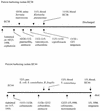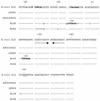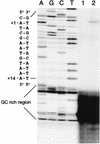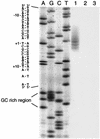High-level expression of ampC beta-lactamase due to insertion of nucleotides between -10 and -35 promoter sequences in Escherichia coli clinical isolates: cases not responsive to extended-spectrum-cephalosporin treatment
- PMID: 12821459
- PMCID: PMC161857
- DOI: 10.1128/AAC.47.7.2138-2144.2003
High-level expression of ampC beta-lactamase due to insertion of nucleotides between -10 and -35 promoter sequences in Escherichia coli clinical isolates: cases not responsive to extended-spectrum-cephalosporin treatment
Abstract
Two Escherichia coli isolates were recovered from the blood of two cancer patients and were demonstrated to produce high levels of the AmpC beta-lactamase with isoelectric points of >9.0. The hypertranscription of ampC RNA was observed by Northern blot hybridization in both isolates. One isolate (isolate EC44) had a point mutation (G-->A at position -28) and insertion of thymidine between positions -20 and -19 of the ampC promoter gene (GenBank accession no. AE000487). The single nucleotide insertion of T between positions -19 and -20 created an optimal distance (17 bp) in the Pribnow box for ampC hyperproduction. The other isolate (isolate EC38) had two point mutations (G-->A at position -28 and C-->T at position +58) and a 2-base (GT) insertion between positions -14 and -15. Although the insertion of GT between positions -14 and -15 may create a new promoter next to the original promoter, cloning of the ampC region with truncated nucleotides of the original -35 region of EC38 failed to verify the hypothesis that a new promoter would be created by such a nucleotide insertion. Instead, multiple start sites for ampC transcription at -1, +1, +2, and +3 were observed in an S1 nuclease protection assay. These results suggest that the RNA polymerase is flexible in the selection of a start site in ampC hypertranscription. In conclusion, nucleotide insertions between the -35 and -10 ampC promoter sequences was the mechanism for the hyperproduction of AmpC beta-lactamase and resistance to oxyimino-cephalosporins. The failure of the two patients to respond to treatment with oxyimino-cephalosporins highlights the important role of such a resistance mechanism in the clinical setting.
Figures







References
-
- Caroff, N., E. Espaze, I. Berard, H. Richet, and A. Reynaud. 1999. Mutations in the ampC promoter of Escherichia coli isolates resistant to oxyiminocephalosporins without extended spectrum beta-lactamase production. FEMS Microbiol. Lett. 173:459-465. - PubMed
-
- Caroff, N., E. Espaze, D. Gautreau, H. Richet, and A. Reynaud. 2000. Analysis of the effects of −42 and −32 ampC promoter mutations in clinical isolates of Escherichia coli hyperproducing ampC. J. Antimicrob. Chemother. 45:783-788. - PubMed
Publication types
MeSH terms
Substances
Associated data
- Actions
LinkOut - more resources
Full Text Sources
Medical
Miscellaneous

